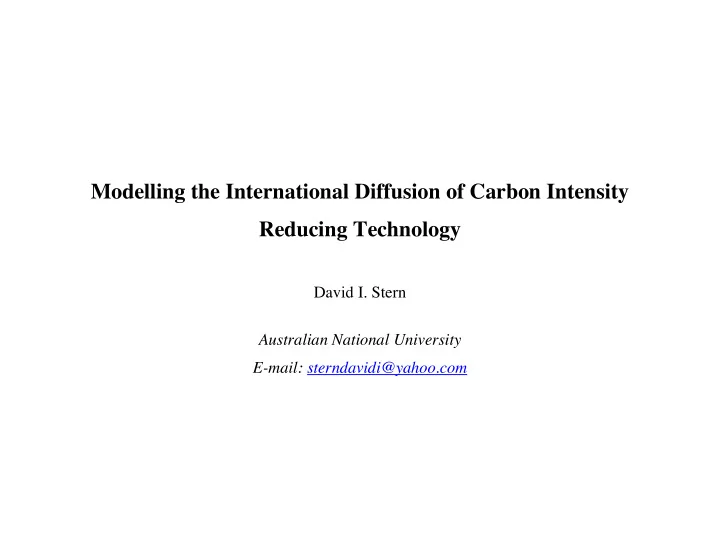

Modelling the International Diffusion of Carbon Intensity Reducing Technology David I. Stern Australian National University E-mail: sterndavidi@yahoo.com
The Environmental Kuznets Curve Model EKC: inverted-U relation between income and emissions or impact: ln(E/P) it = α i + γ t + β 1 ln(GDP/P) it + β 2 (ln(GDP/P)) 2it + ε it Environmental Kuznets Curve (Source: Panayotou, 1993) 300 250 200 150 100 50 0 0 5000 10000 15000 20000 25000 30000 $ GNP per Capita
0.3 World OECD 0.2 Non-OECD 0.1 0 -0.1 -0.2 -0.3 1960 1965 1970 1975 1980 1985 1990 Figure 4. Time effects: first differences sulfur EKC. Source: Stern and Common (2001).
Developing an Alternative Approach
Sulfur Emissions Frontier Model Frontier model: g f ( E it , y it , x it , A t , g ) = d it Emissions distance function (Cobb-Douglas-Linear): E + ln A t E + � � ln E it = ln d it � j ln y jit + � s ln( � k x kit ) + u it j k E � 1 � � � j = 0 � k = 1 ln d it
Results from Previous Studies
Kilograms of Oil Equivalent per $ 0.1 0.2 0.3 0.4 0.5 0.6 0.7 0.8 0 1971 1973 1975 1977 1979 1981 1983 1985 Energy Intensity 1987 1989 1991 1993 1995 1997 USA Mexico Canada 1999 2001 2003
Kilograms of Carbon per $ 0.05 0.15 0.25 0.35 0.1 0.2 0.3 0.4 0 1971 1973 1975 1977 1979 1981 1983 Carbon Intensity 1985 1987 1989 1991 1993 1995 1997 USA Mexico Canada 1999 2001 2003
Energy Technology Trends 0.1 Canada 0.09 Mexico USA 0.08 0.07 0.06 0.05 0.04 0.03 0.02 0.01 0 1971 1973 1975 1977 1979 1981 1983 1985 1987 1989 1991 1993 1995 1997 1999 2001 2003
State Variable (A+d) 0.9 Australia 0.8 Austria Belgium 0.7 Denmark Finland 0.6 France Germany 0.5 Greece Italy 0.4 Japan Netherlands 0.3 Portugal Spain 0.2 UK USA 0.1 0 1971 1973 1975 1977 1979 1981 1983 1985 1987 1989 1991 1993 1995 1997 1999
2003 2002 2001 2000 1999 China: Commercial Energy Intensity 1980-2003 1998 1997 1996 1995 1994 1993 1992 1991 1990 1989 1988 1987 1986 1985 1984 1983 1982 1981 1980 6.1 5.9 5.7 5.5 5.3 5.1 4.9 4.7 Logarithm of Energy Intensity
China: Simplified Decomposition of Energy Intensity Change 1980-2003 60 40 20 0 1980-1985 1985-1988 1988-1989 1989-1990 1990-1995 1995-2000 2000-2003 -20 GSCE/RMB -40 -60 -80 -100 -120 △ Itec △ Istrs △ Istri △ Itot
Exploring the Preference Side
Table 3 Correlation Matrix lnDISTANCE lnSTATE lnGDP/P lnGDP lnP/A lnS*/A lnDISTANCE 1.000 lnSTATE 0.751 1.000 lnGDP/P 0.059 –0.363 1.000 lnGDP 0.406 0.262 0.456 1.000 lnP/A –0.213 –0.216 –0.088 0.136 1.000 lnS*/A –0.308 –0.287 –0.016 –0.011 0.942 1.000
Goals for EERH Project Modeling Energy and Carbon Technology Trends: • Include China & India • Add more recent data • Improve dynamic specification Modeling Technology Choice: • Review alternative theories • Test on estimated trends Integrating the Models: • Embed the models in a growth/projection framework – e.g. Green Solow Model .
Recommend
More recommend